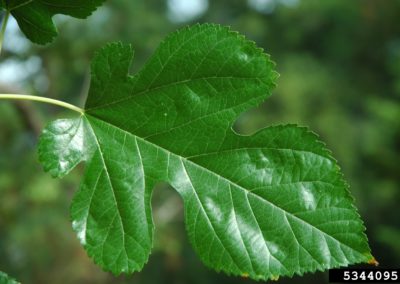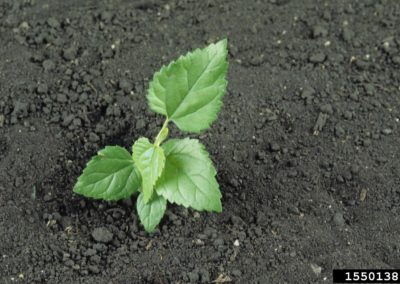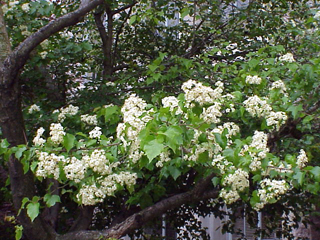White Mulberry (Morus alba)
Invasive Management Profile
White Mulberry has become extremely invasive in Indiana. Be careful when identifying this plant as a White Mulberry so you don’t mistake it for a Red Mulberry.
Identification
White Mulberry leaves are 3-4 inches in length. The upper surface of the leaf is smooth and shiny while the underside is light green. When ripe, White Mulberry fruit is white, red, and purple and grows in small clusters. The White Mulberry Tree has tan/brown bark with thick ridges. It is a tall tree with dense branches. The White Mulberry is often mistaken for Red Mulberry. Red Mulberry has different, oval shaped leaves and is much smaller than the invasive White Mulberry.
Tools & Supplies Needed
- Shovel, spade, or lopper
- Protective eyewear, gloves, and clothing
- Paper or plastic bags for disposal
Removal Methods
STEP 1 : Identify plant using our identification tips and photos as well as the time of year and growth stage.
STEP 2 : Wear protective eyewear, gloves, and clothing.
STEP 3 : Use your hand to grab the bottom of the plant, twist, and pull.
STEP 4 : When pulling, make sure to remove the taproot, which is the main root system (this may be easily removed with a spade or shovel as well).
STEP 5 : Make sure to place all plant debris into a plastic or paper bag to control seed spread.
Depending on the age of the tree, you may need to hire a tree removal service. A full grown White Mulberry will typically cost $500 to $1000 for a professional removal. Click here for information on invasive tree removal companies in your area.
STEP 1 : Identify plant using our identification tips and photos as well as the time of year and growth stage.
STEP 2 : Wear protective eyewear, gloves, and clothing.
STEP 3 : Using an axe or chainsaw cut the tree 5-10 inches from the ground. Be aware of your surroundings and always wear protection when using this equipment.
STEP 4 : Treat with herbicide or remove root system. For removal of the root system, start digging 3 feet away from the base of the stump.
STEP 6 : Once you can see the majority of the rootball, slide your shovel under it and gently begin loosening and prying it up, away from the ground.
STEP 7 : Once the rootball is free place it and all clippings on a tarp to stop the spreading of seeds or regrowth.
One of the simplest methods to kill a full grown White Mulberry Tree is to girdle it.
STEP 1 : Identify plant using our identification tips and photos as well as the time of year and growth stage.
STEP 2 : Wear protective eyewear, gloves and clothing.
STEP 3 : Cut through the bark around the entirety of the base of the tree. This will remove the protective layer of the tree which will allow for water and nutrients to travel from the roots to the rest of the tree.
STEP 4 : Apply herbicide to the removed area to help speed up the process. Click here for herbicide use information.
Disposal
For disposal of White Mulberry, package the plant waste in a large plastic or paper bag for landfill.
Native Alternative Species
To learn more about natives and how to landscape with them click here.
Redbud (Cercis canadensis)
|
Growth Type: Tree
Height: 20 to 30 feet
Spread: 25 to 35 feet
Bloom Time & Description: April; showy pink flower
Fruit: Showy, Edible
Light exposure: Full sun to part shade
Attracts: Butterflies
Tolerate: Deer, Clay Soil, Black Walnut
Find more information here.
|
NEED Photo |





 Photo Courtesy of
Photo Courtesy of